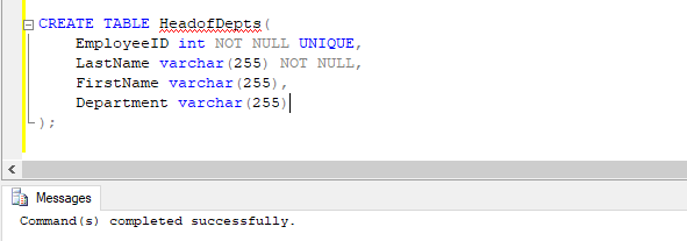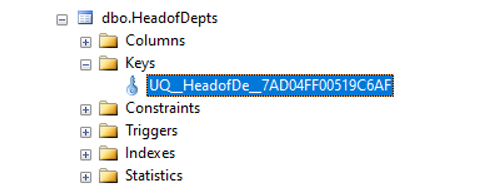Updated March 27, 2023
Introduction to Unique Key in SQL
A unique key is a constraint in SQL which helps in uniquely identifying a record in the data table. It is can be considered somewhat similar to the Primary key as both of them guarantees the uniqueness of a record. But unlike primary key, a unique key can accept NULL values and it can be used on more than one column of the data table.
Why do we need Unique Key in SQL?
A unique key is primarily used for serving the following functions :
1. For fulfilling a specific business case
Suppose we have a case where the primary key uniquely identifies a record in the table. But we want a particular column other than the primary key column to be unique. This can be ensured by a unique key constraint. For example, we have a “teachers” table where the teacher is the primary key and it uniquely identifies the teacher. But we also want to ensure that each teacher teaches a unique subject. So, here unique key constraint comes to our rescue.
2. For maintaining data integrity and extending the primary key
You may use a unique key whenever you want to ensure uniqueness for N number of columns in a data table. For example, we have a table called “HeadofDept” which contains employeeID and department. EmployeeID is the primary key but along with this we also want to ensure that one employee should not handle more than one department. So, in this case, we can use a Unique key constraint on the department to ensure uniqueness.
3. For speeding up information retrieval
We should understand that a unique key is a combination of a unique index and a unique constraint. Hence, a unique index helps in speeding up the retrieval performance.
4. For reducing overheads in joining tables
The unique index ensures the uniqueness of a record and hence can be used for joining data tables. This will simplify the logic and reduce overhead on the human brain.
Working of Unique Key in SQL
The working of the unique key in SQL is given below:
1. Unique Key Constraint with CREATE TABLE statement
Syntax
CREATE TABLE table_name
(
Column_name1 datatype [NULL | NOT NULL] UNIQUE,
Column_name2 datatype [NULL | NOT NULL],
Column_name3 datatype [NULL | NOT NULL]
);This is the basic SQL syntax for creating a unique key constraint using the CREATE TABLE clause.
Parameters
The parameters used here are:
- CREATE TABLE: This statement is used for creating a new table in a database.
- Column_name1, Column_name2,Column_name3: Mention the name of columns you want to create in the table.
- datatype: Mention the datatype of each column in the table.
- [NULL | NOT NULL]: Mention if it can hold NULL values or not
- UNIQUE: Unique keyword written with the column name creates a unique key constraint. It ensures that there are no duplicate values in that particular column.
Of the above-mentioned parameters, CREATE TABLE, one column_name and UNIQUE are mandatory parameters.
Example #1 – While Creating a Table.
Let’s look at an example of how to create a unique key constraint in SQL Server using the CREATE TABLE statement. We will be creating a table named “HeadofDepts” with columns such as EmployeeID, LastName, FirstName, and Department.
On one column “EmployeeID”
Code:
CREATE TABLE HeadofDepts(
EmployeeID int NOT NULL UNIQUE,
LastName varchar(255) NOT NULL,
FirstName varchar(255),
Department varchar(255)
);Output:
We can check from the table properties if we were successfully able to create a unique key constraint.
On multiple columns “EmployeeID” and “Department”
Code:
CREATE TABLE HeadofDepts(
EmployeeID int NOT NULL,
LastName varchar(255) NOT NULL,
FirstName varchar(255),
Department varchar(255),
CONSTRAINT unique_hod UNIQUE (EmployeeID,Department)
);Output:
We can check from the table properties if we were successfully able to create the unique key “unique_hod” constraint.
In the above example, we have created a unique key constraint, called “unique_hod”. This unique key will ensure that EmployeeID and Department name remains unique and consistent throughout the data table
2. Unique Key Constraint with ALTER TABLE statement
Syntax
ALTER TABLE tablename
ADD UNIQUE (column_name);Parameter:
The parameters used here are :
- ALTER TABLE: This statement is used to add and drop constraints from an existing table.
- Tablename: Name of the existing table which you want to modify.
- ADD UNIQUE: Unique keyword written with the column name creates a unique key constraint. It ensures that there are no duplicate values in that particular column.
- Column_name: Name of the column where you want uniqueness.
Example #2 – While Altering a Table.
Let’s look at an example of how to create a unique key constraint in SQL Server using the ALTER TABLE statement.
On one column “EmployeeID”
ALTER TABLE HeadofDepts
ADD UNIQUE (EmployeeID);Output:
We can check from the table properties if we were successfully able to alter the table properties to add the unique key constraint.
On multiple columns “EmployeeID” and “Department”
ALTER TABLE HeadofDepts
ADD CONSTRAINT unique_hod (EmployeeID, Department);In the above example, we have created a unique key constraint, called “unique_hod”. This unique key will ensure that EmployeeID and Department name remains unique and consistent throughout the data table.
3. Unique Key Constraint with DROP TABLE statement
Syntax
ALTER TABLE table_name
DROP CONSTRAINT constraint_name;The parameters used here are :
- ALTER TABLE: This statement is used to add and drop constraints from an existing table.
- Tablename: Name of the existing table which you want to modify.
- DROP CONSTRAINT: Unique keyword written with the column name creates a unique key constraint. It ensures that there are no duplicate values in that particular column.
- Constraint_name: Name of the unique key which you want to delete.
Example #3 – To Remove of Unique Key Constraints
Let’s look at an example of removing a unique key constraint in SQL Server using the DROP TABLE statement.
ALTER TABLE HeadofDepts
DROP CONSTRAINT unique_hod;Output:
We can check from the table properties if we were successfully able to drop the unique key “unique_hod” constraint.
In the above example, we have removed the unique key constraint, “unique_hod” which we created using an alter table and create table statements.
Recommended Articles
We hope that this EDUCBA information on “Unique Key in SQL” was beneficial to you. You can view EDUCBA’s recommended articles for more information.













